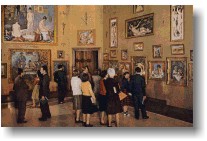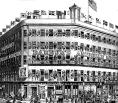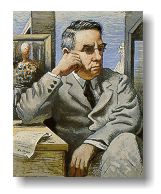
A Prison for Art
I have always found the Barnes Foundation just a bit too hard to get to and some of its rules strange. There’s not enough parking. You have to pay in advance by credit card when you book and there are no cancellation refunds. With your online confirmation, you will learn:
All coats and similar bulky garments, which do not fit flush against the body, must be checked in the Coat Check Room.
Galleries are kept at a constant temperature of 70 degrees.We recommend that you wear a sweater or long-sleeved shirt for comfortable viewing, since coats/jackets cannot be worn.
[But I thought they could be worn if they “fit flush against the body.”]
Visitors must remain at least 18 inches from all objects displayed in theGallery.
And most bizarre of all:
Shoes with heels smaller than 2 inches in diameter may not be worn in the Gallery.
Since high heels have heels smaller than two inches, I can only conclude that this rule is to protect women from the deleterious effects of these once-again fashionable torture instruments. Or is someone afraid women will use their stilettos to attack the Matisse paintings? Or other visitors?
Sure, maybe it’s the soft floors, but hasn’t anyone heard of gymnasium wax?
I cheer the new court-approved relocation of patent-medicine tycoon Albert C. Barnes’ celebrated collection of paintings by Matisse, Renoir, and Cézanne from proper main line Merion, where apparently it was not particularly appreciated, to downtown Philadelphia proper. It is hoped tourists will flock in droves, bringing life and money to the Haussmann-type boulevard called the Benjamin Franklin Parkway.
Now that Barnes’ eccentric will has been broken by a judge of the Orphans Court, the move will be financed with $150 million promised to be raised by the Pew, Annenberg, and Lenfest foundations. There is no need here to go into back-story detail. The possibly elitist community of Merion restricted visitor parking, which therefore restricted visitor income, and the small Barnes board, dominated by nonart types from nearby Lincoln University, somehow…Well, there was so little money left, they had to tour some of the more famous paintings for cash, in spite of Barnes’ will that disallowed such traveling shows. The board still couldn’t make a go of it. Never mind, a new, expanded board with some art experience might take care of things.
And the relocation site?
I was in Philadelphia for Christmas, so I checked out the designated property, the Youth Study Center, a juvenile prison across the street from the Whole Foods supermarket I sometimes frequent. Around the other side, the detention center is indeed on Benjamin Franklin Parkway, between the public library and the wee Rodin Museum, but nowhere near the Philadelphia Museum of Art. The PMA lords it over the entire expanse from a hill at the end-point of the Parkway. On foot it is too far away. A proposed Calder Museum may be sited along this thoroughfare as well, but the idea that art tourists will walk from museum to museum along such an off-putting expanse has to be a joke. No Philadelphian will.
Many still believe that the PMA was placed outside the center of town on a hill at the end of the specially built parkway to protect the art from citizens still unfortunate enough to live in formerly plague-ridden, certainly immigrant-infested, Center City. Those claustrophobia-inducing row-houses look charming now, but in the 18th century they were tombs. Charles Brockden Brown, America’s first novelist, gives a first-hand account of Philadelphia’s 1793 yellow fever epidemic in his 1799 Arthur Mervyn. Malaria and cholera are not soon forgotten. Immigrants, of course, were a bother to Anglo-Americans everywhere.
Contrary to its publicity efforts, Philadelphia is not a walking city. Try walking from Independence Hall to the PMA. Little boys may see dead people, but after six no one else is around. Except for the Avenue of the Arts before and right after showtime, you don’t see anyone in the streets.
I admit that when I was a youth I periodically trudged from the Greyhound Station to the Museum on the Hill, and gladly so. But only in broad daylight. Let us hope that a free tram or a monorail will materialize along the dreaded Benjamin Franklin Parkway, and not just a windswept, isolated outdoor café, such as now planned for the sidewalk in front of Moore College of Art. Moore College isfamous in my mind for having torturedAlice Neel (or so she told me), Philadelphia’s most famous painter since Thomas Eakins. Eakins was kicked out of the Philadelphia Academy of the Fine Arts (nowhere near the Parkway) for using fully nude male models in his drawing classes.
Of course, people do get around the Mall in D.C., but I think it will take more than a parade of outdoor cafés to get them to stroll the Parkway of deadly crossings and zero inhabitants. No doorways means no lurking beggars, but it also means no shelter for the skittish.
I’m sure the Barnes relocation will all fall into place. However, I think the juvenile prison should not be razed, but instead be converted to museum use. It is strangely postmodern just as it is. Money saved could be used for more free days for the workers whom Mr. Barnes tried so desperately to educate about art.
But my second idea is more important. And because it is so important it will take us a little while to get there.

The Barnes Ensemble
I agree that ideally Barnes’ eccentric installations should be replicated as exactly as possible. He placed tools and other decorative or useful objects alongside his precious Matisse and Renoir paintings to make formal and subject-matter connections. He put together paintings of all sizes and even included African art. He was a friend and supporter of philosopher John Dewey, who became his first education director.
Dewey was one of the leading lights of Pragmatism, a much misunderstood philosophy. His Art and Experience, with its effort to show a real and even a practical connection between art and life, was an early influence on yours truly and thus instrumental in the founding of Artopia. So I suspect Barnes’ violation of the strict hierarchy of art, usually practiced by museums, was intentional. In fact, the foundation is a school as well as a museum, teaching his view of art to a dwindling number of students.
We salute and wish to continue to honor Barnes’ chutzpah. And there is another reason for retaining his special arrangements or ensembles.
How tedious indeed is the march of paintings across white walls. Once in awhile we like things skied and categories mixed up. We also like to see some suggestion of the history of display in museums and homes; which is why we like the Isabella Stewart Gardner Museum in Boston and the Frick in New York, and we even like nonart museums like the glorious Mütter Museum, also in Philadelphia (but not on the Parkway and probably never to be so positioned). The Mütter, whose director Gretchen Worden just passed away, is an intact medical college teaching-museum, replete with wax versions of skin diseases, trays of things found in people’s throats, and a whole display on Siamese twins, not to mention a corpse that has turned to soap.
The Barnes is not only a museum but was meant as an art school and has been one since it was founded. Here, as an example of Barnesian art education, are two of the classes currently being offered:
The Active Eye: Art and Sense – Ability
Learn to tap your natural creativity, recognize it in others and incorporate creative thinking in your life and work. Students will experience painting and sculpture using their active eye and discover how artists think and create. The class will attempt to integrate visual phenomenon with sensory awareness, investigating how thoughts, emotions, and sensation can determine how and what we see.
Poetic Structure and Natural Elements in Art
Explore the theme of natural elements: earth, air, fire and water through philosophy, literature, poetry and the art collection of The Barnes Foundation. Students will study themes in Barnes’s installations, and the relevance of natural elements in the arts of diverse cultures.

P.T. Barnum’s American Museum (1841-65)
This Way to the Egress
Yes, the ideal would be to replicate exactly the Barnes art ensembles. But you and I know that only in Artopia are ideals achieved. In real life, time goes by and there are emergencies, fancied and otherwise. Someone might come up with a new way of teaching art that is much more effective than Barnes’ juxtapositions. Or people may just become bored with the same old arrangements. So, not only as an educational creation in itself but also as a fallback, the Barnes should create a virtual tour of the museum to record exactly the way the founder of the foundation intended the art to be shown.
Do the required panoramic digital imaging now, before it’s too late. The rooms and their educational ensembles can then be available online, even during the move to the Benjamin Franklin Parkway..
How did I get this idea? In my last installment, which investigated some museum issues in a satirical way, I needed a marker for the origins of museums in the U.S. and googled P.T. Barnum’s American Museum, which you may remember was set in place at Anne Street and Broadway in1841 and burned to the ground in 1865.
A site called the Lost Museum allows you to pan a 360-degree digital reconstruction of three floors of this lost museum. It’s like those 360-degree apartment, bed-and-breakfast or hotel panoramas on the internet, except this one is “bigger,” educational, more fun. You cannot really find Chang & Eng or the infamous FeJee Mermaid, and I would like the many paintings on its walls zoom-able and identifiable. Even though you might not be able to locate George Catlin’s painting An Iowa Addressing a London Audience, you are looking nevertheless at much more than kitchens or headboards. You are in a museum.
Elsewhere on the site (prepared by the City University of New York), you can access some fascinating documents:
Here’s an excerpt from Barnum’s letter to The Nation dated July 29, 1865, answering an attack, but relevant to the notion of for-profit museums (see last week’s entry below) and museum rules (see above):
I am not thin-skinned, and I know my Museum was not so refined or classic or scientifically arranged as the foreign governmental institutions, for mine had to support my family, while those require annually from the government thousands of pounds. “That class for which it [my Museum] would seem to have been originally intended” would not support a proper museum pecuniarily. More’s the pity-but such is the stern fact. Hence, to make it self-supporting, I was obliged to popularize it, and while I still held on to the “million of curiosities,” millions of people were only induced to see them because, at the same time, they could see whales, giants, dwarfs, Albinoes, dog shows, et cetera…
I permitted no intoxicating liquors in the Museum. I would not even allow my visitors to “go out to drink” and return again without paying the second time, and this reconciled them to the “ice-water” which was always profuse and free on each floor of the Museum. I could not personally or by proxy examine into the character of every visitor, but I continually had half a score of detectives dressed in plain clothes, who incontinently turned into the street every person of either sex whose actions indicated loose habits


Albert Barnesby De Chirico P.T. Barnum
The Virtual Barnes
This week I looked for other online museum tours. Many listed as virtual tours are not sideshows like the Barnum Museum’s, but only slide shows. I prefer the interactive. I want to pan and zoom. Why can’t museums use a system (like a screen-saver I once had) that will allow you to turn corners and go down hallways as well as pan and zoom?
Yet there are some remarkable virtual tours. I would cite as visit-worthy the virtual Metropolitan Museum of Art, the virtual Louvre and the virtual Ringling Museum. At the Met online you can not only pan 360 degrees around the Frank Lloyd Wright room, but zoom in for details and then click for multiple views and see a drop-leaf table in action. There are also some little bits of strangeness here and there: the virtual San Jose Museum of Art features the museum’s store and café!
All the virtual tours are, of course, a bit ghostly, since no people are seen. No heads, hats or stupid remarks get in your way. Or docent prattle.
The solitude is refreshing at first, but then uncanny, making one think about museum visits as social functions. I may now have to rethink my priorities. I am I confess quite irritable when there are people around me at museums and there’s noise. It’s the difference between watching a movie in a theater and watching it home on a DVD. Which is more real?
Nevertheless, pedagogically a virtual Barnes might have its place. It would reach millions who can’t come to Philadelphia. It would spread the Barnes art gospel world-wide. Visitors could get drunk, have “loose habits” and even wear high-heel shoes and/or cowboy boots.
But we can’t stop here; we have to extrapolate.
Why not have a museum that only exists online? We could conjure up our own ideal museum with the art we like, in arrangements we have designed.
Using those little pointers, we could “walk” through gallery after gallery without moving an inch. We could walk through all of art history, or create an alternate art history at will. Every art teacher could design his or her own Museum of Modern Art or Louvre. We can invent museums that no one has ever thought of before. And not have to deal with architecture, architects, parking, board members, climate control, archival standards, and other tedious things.
With all this in mind, I have invented The Curator Game (registered trade mark) that would allow you to rearrange the MoMA galleries at will, using virtual paintings and sculptures in the virtual spaces. The same could be done for the Whitney or SF MoMA or the Metropolitan Museum of Art. It would be even more educational if you could play with all the works in these collections, not only the ones that happen to have been selected for display. Or make up ideal exhibitions, thematic or otherwise, from any number of collections.
There would be a special edition for artists: you could design your own museum exhibition and include your own art. Where would you put your best artwork? Next to Pollock or Duchamp or next to Brice Marden? You could mount your own retrospective too, perhaps made up of works you have never made.
Note: When I was establishing the links for the various virtual museum tours, I noticed that the Metropolitan Museum already has a site called MyMet Gallery. You have to register, but then you can “gather your favorite works of art from the Museum’s online collection.” The resulting display, however, is not a virtual, interactive panorama.
